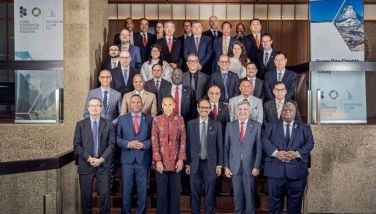Ethanol plants to rise in Negros
November 4, 2006 | 12:00am
The common mantra from the National Bioethanol Council — for Negros Occidental, sugarcane for food. Ethanol, sugarcane is expandable areas of the country.
But this runs counter to the realities on the ground. That’s why the recent signing of an agreement for the construction of bioethanol plants in Negros Occidental at the estimated cost of P65 million caught many by surprise.
According to Rep. Ignacio Arroyo, the memorandum of agreement was signed by Luo Yan, president of China’s CAMC Engineering Co. Ltd., and Aurelio Lacson, president of the Southern Negros Integrated Biofuels Company.
Bacolod City Rep. Monico Puentevella, who witnessed the MOA signing, admitted that he was surprised by the development. The final contract will be signed though in December after the details are discussed.
The agreement was signed in the presence of President Arroyo, First Gentleman Jose Miguel Arroyo, Chinese Ambassador Li Jinjin, Agriculture Secretary Arthur Yap and several officials of CAMCE.
If the projects push through, it will provide opportunities for work to some 5,000 Negrenses as each plant is projected to hire 1,000 more internal workers.
Lacson said the MOA paves the way for the activation of the ethanol distilleries in Murcia town and in Decongcongon, Kabanakalan City.
Businessman Jose Revilla also signed a MOA for the construction of another ethanol plant in Zamboanga del Norte, which is one of the so-called expansion areas for sugarcane.
With the National Bioethanol Council’s insistence that Negros will mostly confine itself to producing sugar as food, it may surprise a lot to know that the Decongcongon sugar mill in upper Kabanakalan City is no longer operating.
Rolando Parpa, director of the Decongcongon Sugar Producers Cooperative Marketing Association, said that about 300 employees of the sugar mill have not received salaries for about three months now. The mill reportedly owed them P4 million in back wages as of last week.
Negros Occidental Gov. Jose Marañon has called on Wilfred Miraflores, mill president, and Parpa to find solutions to the plight of workers.
Amertech International Ventures, an American firm, had reportedly assured that it will lease the mill for 10 years and will be responsible for paying the obligations of the mill to the workers.
Miraflores told Marañon he would set a deadline for Amertech to deliver its promise. Otherwise, he said, he will turn to the governor for assistance in addressing the problem of the workers who are considered laid off.
Parpa proposed an immediate takeover of the mill by the Philippine Sugar Corp. He said Philsucor had already agreed to continue financing the mill provided that management is turned over to the government sugar corporation.
This is just one of the harsh realities that makes it possible for Negros Occidental to join the ethanol distilling project.
In Murcia, most of the sugar farmers will mill their sugarcane with the First Farmers Milling Company in Talisay City. Many used to mill with the former Maao Sugar Central owned by the Aranetas. Unfortunately, that mill no longer exists. Thus, there are thousands of hectares of sugarlands begging for accommodation by various operating mills in Negros. In short, what seems impossible has become more possible now with the closure of these two mills in addition to the San Carlos mill in Northern Negros Occidental, where the San Carlos Bioethanol plant is scheduled to start operations next year.
Roberto Montelibano, president of the Metro Bacolod Chamber of Commerce and Industry (MBCCI), said that the signing of the MOA in Nanning, China, was a manifestation that ethanol production will soon be a "big deal in Negros."
As mentioned in my column earlier, I was trying to get feedback on the controversial Aswang Festival in Roxas City held last Oct. 27 and 28.
Despite the appeal by Capiz Archdiocesan authorities for the faithful to boycott the affair and to spend their day praying inside churches, the city streets were filled with curious watchers as captured by television.
The crowd showed their appreciation of the celebration, although there were only two tribes who joined the street-dancing exhibition.
Abes Cheryl Lastimoso, president of the Dugo Capiznon Inc. (DCI) admitted that lack of logistics pared down the participants from five last year to only two this year.
"But we hope to be able to attract more sponsors next year," Lastimoso said.
Prior to the festival, Capiz Archbishop Onesimo Gordoncillo had released a pastoral letter denouncing the affair. Four days before the festival, the Church also held a caravan to dramatize its opposition to the Aswang Festival. It was considered one of the biggest caravans ever held in Capiz.
Recently, Msgr. Hilata, vicar general of the Capiz Archdiocese, also released another pastoral letter inviting Catholics to a more positive posture against the festival.
DCI spokesperson Arnel Estiaga insisted on the validity of their objective – to debunk the myth of Capiz as the land of witches by capitalizing on the negative image of the province.
But that very argument was the one which Gordoncillo said is projecting Capiz’s negative image.
Anyway, Lastimoso’s latest statement, more or less, serves notice that the DCI, which is the principal sponsors of the Aswang Festival, promises a bigger event next year.
The issues have been joined. Let’s watch and see how things turn out next year.
It has been building up for years. But this time, it became evident that Bacolod as well as Iloilo City authorities can no longer just close their eyes to the reality that public cemeteries have become overcrowded.
Iloilo City Mayor Jerry Trenas admitted on television that the situation cannot long be allowed to fester. "That’s the reason why the city government is looking for an alternative place for a new public cemetery," Trenas said.
In Bacolod, the Burgos public cemetery, there are numerous additions to original tombstones or grave sites and there is no more space.
Privately owned memorial parks have relieved the situation. But these are high-priced. And the poor must still contend with the public cemeteries.
But that’s not true only with the city-based public burial grounds. The one in Barangay Fabrica, of Sagay City, already has some tombs containing as many as 10 remains.
There are actually many places with a similar dilemna. Now, it’s not just a question of urban housing, but also resting places for the dead, which may soon become a problem for local government units.
But this runs counter to the realities on the ground. That’s why the recent signing of an agreement for the construction of bioethanol plants in Negros Occidental at the estimated cost of P65 million caught many by surprise.
According to Rep. Ignacio Arroyo, the memorandum of agreement was signed by Luo Yan, president of China’s CAMC Engineering Co. Ltd., and Aurelio Lacson, president of the Southern Negros Integrated Biofuels Company.
Bacolod City Rep. Monico Puentevella, who witnessed the MOA signing, admitted that he was surprised by the development. The final contract will be signed though in December after the details are discussed.
The agreement was signed in the presence of President Arroyo, First Gentleman Jose Miguel Arroyo, Chinese Ambassador Li Jinjin, Agriculture Secretary Arthur Yap and several officials of CAMCE.
If the projects push through, it will provide opportunities for work to some 5,000 Negrenses as each plant is projected to hire 1,000 more internal workers.
Lacson said the MOA paves the way for the activation of the ethanol distilleries in Murcia town and in Decongcongon, Kabanakalan City.
Businessman Jose Revilla also signed a MOA for the construction of another ethanol plant in Zamboanga del Norte, which is one of the so-called expansion areas for sugarcane.
Rolando Parpa, director of the Decongcongon Sugar Producers Cooperative Marketing Association, said that about 300 employees of the sugar mill have not received salaries for about three months now. The mill reportedly owed them P4 million in back wages as of last week.
Negros Occidental Gov. Jose Marañon has called on Wilfred Miraflores, mill president, and Parpa to find solutions to the plight of workers.
Amertech International Ventures, an American firm, had reportedly assured that it will lease the mill for 10 years and will be responsible for paying the obligations of the mill to the workers.
Miraflores told Marañon he would set a deadline for Amertech to deliver its promise. Otherwise, he said, he will turn to the governor for assistance in addressing the problem of the workers who are considered laid off.
Parpa proposed an immediate takeover of the mill by the Philippine Sugar Corp. He said Philsucor had already agreed to continue financing the mill provided that management is turned over to the government sugar corporation.
This is just one of the harsh realities that makes it possible for Negros Occidental to join the ethanol distilling project.
In Murcia, most of the sugar farmers will mill their sugarcane with the First Farmers Milling Company in Talisay City. Many used to mill with the former Maao Sugar Central owned by the Aranetas. Unfortunately, that mill no longer exists. Thus, there are thousands of hectares of sugarlands begging for accommodation by various operating mills in Negros. In short, what seems impossible has become more possible now with the closure of these two mills in addition to the San Carlos mill in Northern Negros Occidental, where the San Carlos Bioethanol plant is scheduled to start operations next year.
Roberto Montelibano, president of the Metro Bacolod Chamber of Commerce and Industry (MBCCI), said that the signing of the MOA in Nanning, China, was a manifestation that ethanol production will soon be a "big deal in Negros."
Despite the appeal by Capiz Archdiocesan authorities for the faithful to boycott the affair and to spend their day praying inside churches, the city streets were filled with curious watchers as captured by television.
The crowd showed their appreciation of the celebration, although there were only two tribes who joined the street-dancing exhibition.
Abes Cheryl Lastimoso, president of the Dugo Capiznon Inc. (DCI) admitted that lack of logistics pared down the participants from five last year to only two this year.
"But we hope to be able to attract more sponsors next year," Lastimoso said.
Prior to the festival, Capiz Archbishop Onesimo Gordoncillo had released a pastoral letter denouncing the affair. Four days before the festival, the Church also held a caravan to dramatize its opposition to the Aswang Festival. It was considered one of the biggest caravans ever held in Capiz.
Recently, Msgr. Hilata, vicar general of the Capiz Archdiocese, also released another pastoral letter inviting Catholics to a more positive posture against the festival.
DCI spokesperson Arnel Estiaga insisted on the validity of their objective – to debunk the myth of Capiz as the land of witches by capitalizing on the negative image of the province.
But that very argument was the one which Gordoncillo said is projecting Capiz’s negative image.
Anyway, Lastimoso’s latest statement, more or less, serves notice that the DCI, which is the principal sponsors of the Aswang Festival, promises a bigger event next year.
The issues have been joined. Let’s watch and see how things turn out next year.
Iloilo City Mayor Jerry Trenas admitted on television that the situation cannot long be allowed to fester. "That’s the reason why the city government is looking for an alternative place for a new public cemetery," Trenas said.
In Bacolod, the Burgos public cemetery, there are numerous additions to original tombstones or grave sites and there is no more space.
Privately owned memorial parks have relieved the situation. But these are high-priced. And the poor must still contend with the public cemeteries.
But that’s not true only with the city-based public burial grounds. The one in Barangay Fabrica, of Sagay City, already has some tombs containing as many as 10 remains.
There are actually many places with a similar dilemna. Now, it’s not just a question of urban housing, but also resting places for the dead, which may soon become a problem for local government units.
BrandSpace Articles
<
>
- Latest
- Trending
Trending
Latest
Trending
Latest
Recommended





























